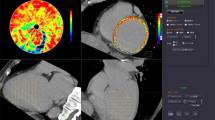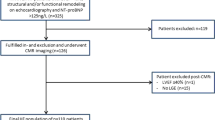Abstract
Recently, myocardial extracellular volume (ECV) analysis has been measurable on computed tomography (CT) using new software. We evaluated the use of cardiac CT to estimate the myocardial ECV of left ventricular (LV) myocardium (LVM) to predict reverse remodeling (RR) in cases of atrial fibrillation (AF) after catheter ablation (CA). Four hundred and seven patients underwent CA for AF in our institution from April 2014 to Feb 2021. Of these, 33 patients (8%) with an LVEF ≤ 50% and who had undergone CT were included in our study. We estimated the LVM ECV using commercial software to analyze the CT data. RR was defined as an improvement in LVEF to > 50% after CA. LVEF increased to > 50% in 24 patients (73%) after CA. In all 24 patients, LVM ECV, LV end-diastolic and end-systolic volumes (LVEDV and LVESV), and the n-terminal fragment of pro-B-type natriuretic peptide (NT-proBNP) were significantly lower than in the other nine patients (P = 0.0037, 0.0273, 0.0443, and < 0.0001). On receiver operating characteristic curve analysis, the best cut-off of ECV, LVEDV, LVESV and NT-proBNP for the prediction of RR were 37.73%, 120 mL, 82 mL, and 1267 pg/mL, respectively. We newly defined the ENL (ECV, NT-proBNP, and LVEDV) score as the summed score for the presence or absence (1 or 0; maximum score = 3) of ECV, NT-proBNP, and LVEDV values less than or equal to each best cut-off value, and found that this score gave the highest area under the curve for the prediction of RR (0.9583, P < 0.0001). The ENL score may be useful for predicting RR in patients with AF undergoing CA.




Similar content being viewed by others
Data availability
No additional data is available.
References
Marrouche NF, Brachmann J, Andresen D, Siebels J, Boersma L, Jordaens L, Merkely B, Pokushalov E, Sanders P, Proff J, Schunkert H, Christ H, Vogt J, Bänsch D, CASTLE-AF Investigators (2018) Catheter ablation for atrial fibrillation with heart failure. New Engl J Med 378:417–427
Cummings KW, Bhalla S, Javidan-Nejad C, Bierhals AJ, Gutierrez FR, Woodard PK (2009) A pattern-based approach to the assessment of delayed enhancement in nonischemic cardiomyopathy at MR imaging. Radiographics 29:89–103
Nakamori S, Dohi K, Ishida M, Goto Y, Imanaka-Yoshida K, Omori T, Goto I, Kumagai N, Fujimoto N, Ichikawa Y, Kitagawa K, Yamada N, Sakuma H, Ito M (2018) Native T1 mapping and extracellular volume mapping for the assessment of diffuse myocardial fibrosis in dilated cardiomyopathy. JACC Cardiovasc Imaging 11:48–59
Grobner T, Prischl FC (2007) Gadolinium and nephrogenic systemic fibrosis. Kidney Int 72:260–264
Taylor AJ, Cerqueira M, Hodgson JM, Mark D, Min J, O’Gara P, Rubin GD, American College of Cardiology Foundation Appropriate Use Criteria Task Force, Society of Cardiovascular Computed Tomography, American College of Radiology, American Heart Association, American Society of Echocardiography, American Society of Nuclear Cardiology, North American Society for Cardiovascular Imaging, Society for Cardiovascular Angiography and Interventions, Society for Cardiovascular Magnetic Resonance (2010) ACCF/SCCT/ACR/AHA/ASE/ASNC/NASCI/SCAI/SCMR 2010 appropriate use criteria for cardiac computed tomography. A report of the American college of cardiology foundation appropriate use criteria task force, the society of cardiovascular computed tomography, the American college of radiology, the American heart association, the American society of echocardiography, the American society of nuclear cardiology, the North American society for cardiovascular imaging, the society for cardiovascular angiography and interventions, and the society for cardiovascular magnetic resonance. J Am Coll Cardiol 56:1864–1894
Uehara M, Takaoka H, Kobayashi Y, Funabashi N (2013) Diagnostic accuracy of 320-slice computed-tomography for detection of significant coronary artery stenosis in patients with various heart rates and heart rhythms compared with conventional coronary-angiography. Int J Cardiol 167:809–815
Takaoka H, Uehara M, Saito Y, Ota J, Iida Y, Takahashi M, Sano K, Komuro I, Kobayashi Y (2020) Improved diagnostic performance of new-generation 320-slice computed tomography with forward-projected model-based iterative reconstruction solution for the assessment of late enhancement in left ventricular myocardium. Intern Med 59:2095–2103
Nacif MS, Kawel N, Lee JJ, Chen X, Yao J, Zavodni A, Sibley CT, Lima JA, Liu S, Bluemke DA (2012) Interstitial myocardial fibrosis assessed as extracellular volume fraction with low-radiation-dose cardiac CT. Radiology 264:876–883
Kidoh M, Oda S, Takashio S, Kanazawa H, Ikebe S, Emoto T, Nakaura T, Nagayama Y, Sasao A, Inoue T, Funama Y, Araki S, Yamamoto E, Kaikita K, Tsujita K, Ikeda O (2020) Assessment of diffuse ventricular fibrosis in atrial fibrillation using cardiac CT-derived myocardial extracellular volume fraction. JACC Clin Electrophysiol 6:1573–1575
Merlo M, Pyxaras SA, Pinamonti B, Barbati G, Di Lenarda A, Sinagra G (2011) Prevalence and prognostic significance of left ventricular reverse remodeling in dilated cardiomyopathy receiving tailored medical treatment. J Am Coll Cardiol 57:1468–1476
Okada M, Tanaka N, Oka T, Tanaka K, Ninomiya Y, Hirao Y, Yoshimoto I, Inoue H, Kitagaki R, Onishi T, Koyama Y, Okamura A, Iwakura K, Sakata Y, Fujii K, Inoue K (2021) Clinical significance of left ventricular reverse remodeling after catheter ablation of atrial fibrillation in patients with left ventricular systolic dysfunction. J Cardiol 77:500–508
Takaoka H, Funabashi N, Uehara M, Fujimoto Y, Kobayashi Y (2013) Diagnostic accuracy of coronary 320 slice CT angiography using retrospective electrocardiogram gated acquisition compared with virtual prospective electrocardiogram gated acquisition with and without padding. Int J Cardiol 168:2811–2815
Yashima S, Takaoka H, Iwahana T, Nishikawa Y, Ota J, Aoki S, Kinoshita M, Takahashi M, Sasaki H, Suzuki-Eguchi N, Goto H, Suzuki K, Kobayashi Y (2022) Evaluation of extracellular volume by computed tomography is useful for prediction of prognosis in dilated cardiomyopathy. Heart Vessels. https://doi.org/10.1007/s00380-022-02154-4
Hamdy A, Kitagawa K, Goto Y, Yamada A, Nakamura S, Takafuji M, Nagasawa N, Sakuma H (2019) Comparison of the different imaging time points in delayed phase cardiac CT for myocardial scar assessment and extracellular volume fraction estimation in patients with old myocardial infarction. Int J Cardiovasc Imaging 35:917–926
Kanaeda T, Ueda M, Arai M, Ishimura M, Kajiyama T, Hashiguchi N, Nakano M, Kondo Y, Hiranuma Y, Oyamada A, Yokosuka O, Kobayashi Y (2015) Evaluation of periesophageal nerve injury after pulmonary vein isolation using the (13)C-acetate breath test. J Arrhythm 31:364–370
Kagawa Y, Fujii E, Fujita S, Ito M (2020) Association between left atrial reverse remodeling and maintenance of sinus rhythm after catheter ablation of persistent atrial fibrillation. Heart Vessels 35:239–245
Andrade JG, Khairy P, Macle L, Packer DL, Lehmann JW, Holcomb RG, Ruskin JN, Dubuc M (2014) Incidence and significance of early recurrences of atrial fibrillation after cryoballoon ablation: insights from the multicenter sustained treatment of paroxysmal atrial fibrillation (STOP AF) trial. Circ Arrhythm Electrophysiol 7:69–75
Demler OV, Pencina MJ, D’Agostino RB Jr (2012) Misuse of DeLong test to compare AUCs for nested models. Stat Med 31:2577–2587
Adademir T, Khiabani A, Schill MR, Sinn LA, Schuessler RB, Moon MR, Melby SJ, Damiano RJ Jr (2019) Surgical ablation of atrial fibrillation in patients with tachycardia-induced cardiomyopathy. Ann Thorac Surg 108:443–450
Medi C, Kalman JM, Haqqani H, Vohra JK, Morton JB, Sparks PB, Kistler PM (2009) Tachycardia-mediated cardiomyopathy secondary to focal atrial tachycardia: long term outcome after catheter ablation. J Am Coll Cardiol 53:1791–1797
Gopinathannair R, Etheridge SP, Marchlinski FE, Spinale FG, Lakkireddy D, Olshansky B (2015) Arrhythmia-induced cardiomyopathies: mechanisms, recognition, and management. J Am Coll Cardiol 66:1714–1728
Jeong YH, Choi KJ, Song JM, Hwang ES, Park KM, Nam GB, Kim JJ, Kim YH (2008) Diagnostic approach and treatment strategy in tachycardia-induced cardiomyopathy. Clin Cardiol 31:172–178
aus dem Siepen F, Buss SJ, Messroghli D, Andre F, Lossnitzer D, Seitz S, Keller M, Schnabel PA, Giannitsis E, Korosoglou G, Katus HA, Steen H (2015) T1 mapping in dilated cardiomyopathy with cardiac magnetic resonance: quantification of diffuse myocardial fibrosis and comparison with endomyocardial biopsy. Eur Heart J Cardiovasc Imaging 16:210–216
Scully PR, Patel KP, Saberwal B, Lotz E, Augusto JB, Thornton GD, Hughes RK, Manisty C, Lloyd G, Newton JD, Sabharwal N, Kelion A, Kennon S, Ozkor M, Mullen M, Hartman N, Cavalcante JL, Menezes LJ, Hawkins PN, Treibel TA, Moon JC, Pugliese F (2020) Identifying cardiac amyloid in aortic stenosis ECV quantification by CT in TAVR patients. JACC Cardiovasc Imaging 13:2177–2189
McCollough CH, Schueler BA (2000) Calculation of effective dose. Med Phys 27:828–837
Yu L, Bruesewitz MR, Thomas KB, Fletcher JG, Kofler JM, McCollough CH (2011) Optimal tube potential for radiation dose reduction in pediatric CT: principles, clinical implementations, and pitfalls. Radiographics 31:835–848
Kitaoka H, Izumi C, Izumiya Y, Inomata T, Ueda M, Kubo T, Koyama J, Sano M, Sekijima Y, Tahara N, Tsukada N, Tsujita K, Tsutsui H, Tomita T, Amano M, Endo J, Okada A, Oda S, Takashio S, Baba Y, Misumi Y, Yazaki M, Anzai T, Ando Y, Isobe M, Kimura T, Fukuda K, Japanese Circulation Society Joint Working Group (2020) JCS 2020 guideline on diagnosis and treatment of cardiac amyloidosis. Circ J 84:1610–1671
Nieman K, Shapiro MD, Ferencik M, Nomura CH, Abbara S, Hoffmann U, Gold HK, Jang IK, Brady TJ, Cury RC (2008) Reperfused myocardial infarction: contrast-enhanced 64-Section CT in comparison to MR imaging. Radiology 247:49–56
Narula J, Chandrashekhar Y, Ahmadi A, Abbara S, Berman DS, Blankstein R, Leipsic J, Newby D, Nicol ED, Nieman K, Shaw L, Villines TC, Williams M, Hecht HS (2021) SCCT 2021 expert consensus document on coronary computed tomographic angiography: a report of the society of cardiovascular computed tomography. J Cardiovasc Comput Tomogr 15:192–217
Acknowledgements
We thank Libby Cone, MD, MA, from DMC Corp. (www.dmed.co.jp <http://www.dmed.co.jp/ >) for editing drafts of this manuscript.
Funding
This work was partially supported by the TSUCHIYA MEMORIAL MEDICAL FOUNDATION (Grant no. J17KF00167).
Author information
Authors and Affiliations
Corresponding author
Ethics declarations
Conflict of interest
No authors have a conflict of interest related to this article.
Additional information
Publisher's Note
Springer Nature remains neutral with regard to jurisdictional claims in published maps and institutional affiliations.
Rights and permissions
Springer Nature or its licensor (e.g. a society or other partner) holds exclusive rights to this article under a publishing agreement with the author(s) or other rightsholder(s); author self-archiving of the accepted manuscript version of this article is solely governed by the terms of such publishing agreement and applicable law.
About this article
Cite this article
Nishikawa, Y., Takaoka, H., Kanaeda, T. et al. A new composite indicator consisting of left ventricular extracellular volume, N-terminal fragment of B-type natriuretic peptide, and left ventricular end-diastolic volume is useful for predicting reverse remodeling after catheter ablation for atrial fibrillation. Heart Vessels 38, 721–730 (2023). https://doi.org/10.1007/s00380-022-02220-x
Received:
Accepted:
Published:
Issue Date:
DOI: https://doi.org/10.1007/s00380-022-02220-x




